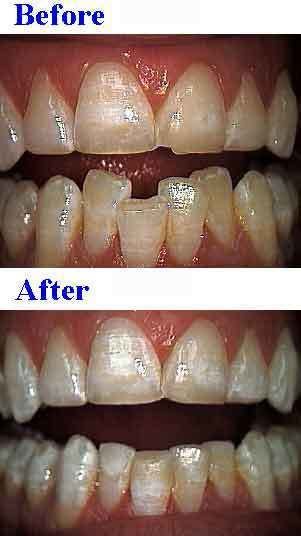 | ||
Cosmetic dentistry is generally used to refer to any dental work that improves the appearance (though not necessarily the function) of a person's teeth, gums and/or bite. It primarily focuses on improvement dental aesthetics in color, position, shape, size, alignment and overall smile appearance. Many dentists refer to themselves as "cosmetic dentists" regardless of their specific education, specialty, training, and experience in this field. This has been considered unethical with a predominant objective of marketing to patients. The American Dental Association does not recognize cosmetic dentistry as a formal specialty area of dentistry. However, there are still dentists that promote themselves as cosmetic dentists.
Contents
Fields
There are primarily two dental specialties that predominantly focus on dental esthetics. They are:
- Prosthodontics and
- Orthodontics
Cosmetic dentistry includes endodontics and also periodontics.
Types
Cosmetic dentistry may involve:
- the addition of a dental material to teeth or gums – examples: bonding, porcelain veneers (laminates), crowns (caps), gum grafts
- the removal of tooth structure or gums – examples: enameloplasty, gingivectomy
- neither adding nor removing dental materials, tooth structure, or gums – examples: teeth whitening (bleaching), laser whitening, gum depigmentation
- straightening of teeth accompanied by improvement in appearance of face – orthodontics
Examples
Materials
In the past, dental fillings and other tooth restorations were made of gold, amalgam and other metals—some of which were veneered with porcelain. Now, dental work can be made entirely of porcelain or composite materials that more closely mimic the appearance of natural tooth structure. These tooth colored materials are bonded to the underlying tooth structure with resin adhesives. Unlike silver fillings (amalgams) they are entirely free of mercury. Cosmetic dentistry has evolved to cover many new procedures and new dental materials are constantly introduced.
Credentialing
In USA, formally trained specialists recognized by the American Dental Association undergo a minimum of 2–3 years full-time rigorous education program after dental school graduation. These specialties also lead to board certification approved by the American Dental Association.
Non-specialists with supplemental education related to specific interests. The certifications by these groups will not lead to approval by the American Dental Association.
American Academy of Cosmetic Dentistry
The American Academy of Cosmetic Dentistry (AACD) is the largest international dental organization in the world, composed of general dentists, specialists, and lab technicians focused on the art and science of cosmetic dentistry. Founded in 1984, the AACD has over 7,000 members in the United States and more than 70 countries around the globe. Members of the Academy include dentists, dental laboratory technicians, educators, researchers, students, hygienists, corporations and dental auxiliaries. AACD members seek out continuing education through lectures, workshops, and publications in order to keep up-to-date with all of the advancements in cosmetic dental techniques and technology. In 1984, the AACD was formed and has filled the dire need for credentialing in cosmetic dentistry. The purpose of the American Board of Cosmetic Dentistry (ABCD) is the testing, analyzing, and evaluation of the services of dentists and laboratory technicians for the purpose of awarding AACD Accreditation in cosmetic dentistry. However, this certification is not approved or recognized by the American Dental Association.
American Society For Dental Aesthetics: Conceived in 1976, the American Society for Dental Aesthetics was developed with a single purpose in mind: continuing dental education to teach dental health professionals the most advanced aesthetic and restorative techniques available. To become a member of the ASDA, a dentist must show a minimum of five years in dental practice, or postgraduate training of two years in an approved program; attendance to at least two ASDA sponsored continuing dental education seminars; nomination by a member accompanied by two letters of recommendation by Society members; presentation of five (5) cases illustrating the concepts of aesthetic dentistry.
History
Newell Sill Jenkins (1840—1919) was an American dentist who practiced most of his life in Dresden, Germany. He developed the Jenkins porcelain enamel and improved, thus making a composition of the porcelain paste, porcelain inlays, dental crowns and bridges. He is thus the founder of aesthetic dentistry.
